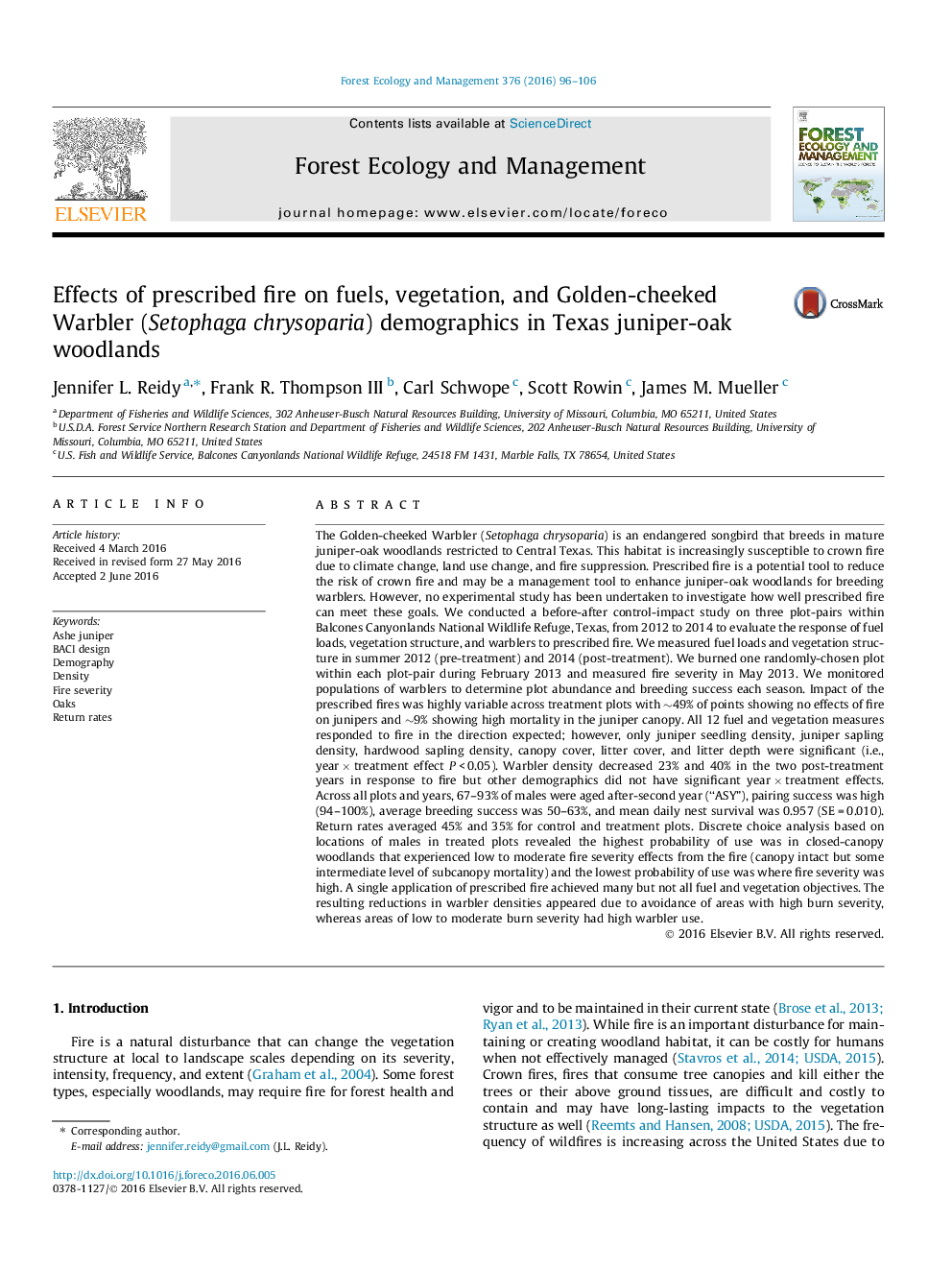| کد مقاله | کد نشریه | سال انتشار | مقاله انگلیسی | نسخه تمام متن |
|---|---|---|---|---|
| 6542104 | 159145 | 2016 | 11 صفحه PDF | دانلود رایگان |
عنوان انگلیسی مقاله ISI
Effects of prescribed fire on fuels, vegetation, and Golden-cheeked Warbler (Setophaga chrysoparia) demographics in Texas juniper-oak woodlands
دانلود مقاله + سفارش ترجمه
دانلود مقاله ISI انگلیسی
رایگان برای ایرانیان
موضوعات مرتبط
علوم زیستی و بیوفناوری
علوم کشاورزی و بیولوژیک
بوم شناسی، تکامل، رفتار و سامانه شناسی
پیش نمایش صفحه اول مقاله

چکیده انگلیسی
The Golden-cheeked Warbler (Setophaga chrysoparia) is an endangered songbird that breeds in mature juniper-oak woodlands restricted to Central Texas. This habitat is increasingly susceptible to crown fire due to climate change, land use change, and fire suppression. Prescribed fire is a potential tool to reduce the risk of crown fire and may be a management tool to enhance juniper-oak woodlands for breeding warblers. However, no experimental study has been undertaken to investigate how well prescribed fire can meet these goals. We conducted a before-after control-impact study on three plot-pairs within Balcones Canyonlands National Wildlife Refuge, Texas, from 2012 to 2014 to evaluate the response of fuel loads, vegetation structure, and warblers to prescribed fire. We measured fuel loads and vegetation structure in summer 2012 (pre-treatment) and 2014 (post-treatment). We burned one randomly-chosen plot within each plot-pair during February 2013 and measured fire severity in May 2013. We monitored populations of warblers to determine plot abundance and breeding success each season. Impact of the prescribed fires was highly variable across treatment plots with â¼49% of points showing no effects of fire on junipers and â¼9% showing high mortality in the juniper canopy. All 12 fuel and vegetation measures responded to fire in the direction expected; however, only juniper seedling density, juniper sapling density, hardwood sapling density, canopy cover, litter cover, and litter depth were significant (i.e., year Ã treatment effect P < 0.05). Warbler density decreased 23% and 40% in the two post-treatment years in response to fire but other demographics did not have significant year Ã treatment effects. Across all plots and years, 67-93% of males were aged after-second year (“ASY”), pairing success was high (94-100%), average breeding success was 50-63%, and mean daily nest survival was 0.957 (SE = 0.010). Return rates averaged 45% and 35% for control and treatment plots. Discrete choice analysis based on locations of males in treated plots revealed the highest probability of use was in closed-canopy woodlands that experienced low to moderate fire severity effects from the fire (canopy intact but some intermediate level of subcanopy mortality) and the lowest probability of use was where fire severity was high. A single application of prescribed fire achieved many but not all fuel and vegetation objectives. The resulting reductions in warbler densities appeared due to avoidance of areas with high burn severity, whereas areas of low to moderate burn severity had high warbler use.
ناشر
Database: Elsevier - ScienceDirect (ساینس دایرکت)
Journal: Forest Ecology and Management - Volume 376, 15 September 2016, Pages 96-106
Journal: Forest Ecology and Management - Volume 376, 15 September 2016, Pages 96-106
نویسندگان
Jennifer L. Reidy, Frank R. III, Carl Schwope, Scott Rowin, James M. Mueller,